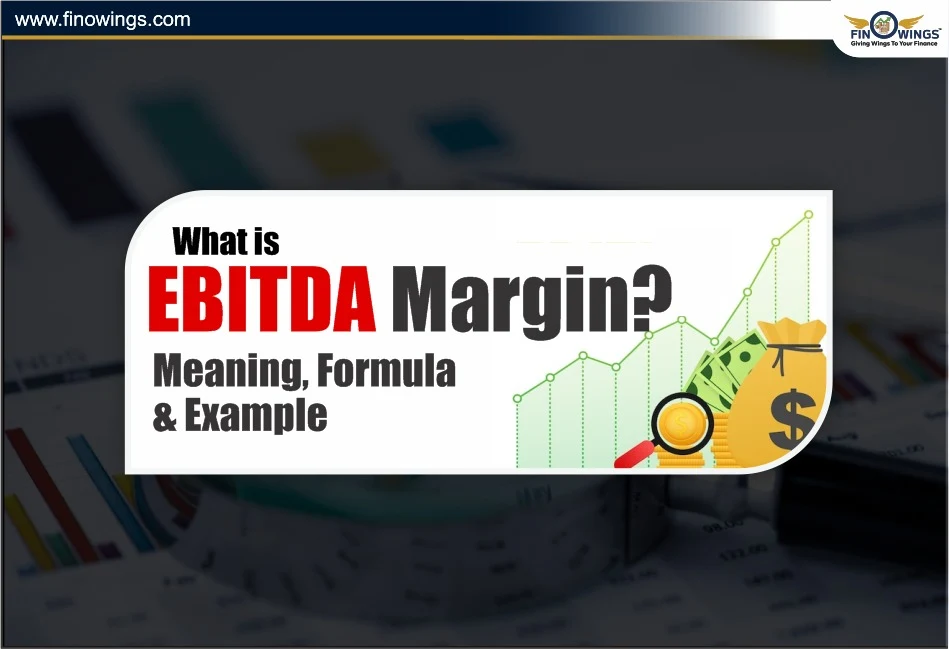Home >> Blog >> What Is EBITDA Margin? Meaning, Formula & Example
What Is EBITDA Margin? Meaning, Formula & Example

Table of Contents
Profitability of a firm can be considered in diverse aspects. One of the most effective ways is to examine EBITDA margin that evaluates the profitability and operations revenue of a company after taking away the expenses of financing, interest, taxes, depreciation, and amortization of the company.
This is the definition of EBITDA margin, the computational formula, the reasons and rationales, and the importance of this indicator in analysing a business and its profitability.
What is EBITDA meaning?
EBITDA refers to the term Earnings Before Interest, Taxes, Depreciation and Amortisation.
This is the amount of cash a company makes from all financing costs, taxes and core operations excluding the most important costs that EBITDA must calculate.
To calculate EBITDA, use the formula,
EBITDA = Net profit + Interest + Taxes + Depreciation + Amortisation
How to Calculate EBITDA margin?
Suppose a company has the following numbers:
Net profit = ₹1,00,00,000, Interest = ₹20,00,000, Taxes = ₹30,00,000, Depreciation = ₹10,00,000, Amortisation = ₹5,00,000
Then,
EBITDA = 1,00,00,000 + 20,00,000 + 30,00,000 + 10,00,000 + 5,00,000 = ₹1,65,00,000
Before taxes and interest, the company has earned ₹1.65 Cr.
How to Calculate EBITDA Percentage?
EBITDA percentage = (EBITDA / Total revenue) × 100
How to Calculate the EBITDA Margin (Step by Step)
-
Get revenue, EBITDA and expenses (via income statement).
-
Now, let’s use the formula-
EBITDA Margin = (EBITDA ÷ Revenue) × 100
-
You desire to know what is the percentage of revenue profit, or profit before tax and depreciation.
Let's say our company possesses the following:
Total Revenue: ₹10 Cr, EBITDA: ₹2.5 Cr
So, EBITDA Margin = (2.5 ÷ 10) × 100 = 25%
EBITDA vs. Operating Profit (EBIT)
EBIT is performance based because it eliminates performance distorting accounting restructurings and this is especially true in capital-intensive sectors such as telecom, power, and manufacturing.
|
Basis |
EBITDA |
EBIT (Operating Profit) |
|
Includes |
Earnings before interest, taxes, depreciation, and amortisation |
Earnings before interest and taxes |
|
Focus |
Measures cash operating profitability |
Includes non-cash charges like depreciation |
|
Use Case |
Best for comparing firms with different asset bases or tax structures |
Reflects profitability after accounting for asset usage |
Purpose of EBITDA Margin
1. An improved EBITDA margin indicates that the company is more efficient in transforming its sales into profit.
2. EBITDA is a strong cross-industry and cross-border comparison tool, as the depreciation and amortization costs within EBITDA have little comparative significance.
3. Investors use EBITDA multiples and compare them to the enterprise value to analyse the operational performance of the business. Valuation of the company also includes EBITDA since it does not include the debt of the business.
The CAPE Ratio assists investors in assessing entire markets over economic cycles, whereas the EBITDA margin concentrates on company-level profitability. When combined, they offer a thorough understanding of financial health, one at the macro level and the other at the local level.
Analysing the Business Performance
Banks and rating agencies use margins for assessing the performance of the business, its capacity to produce cash, and determining the risk associated with its debt obligations.
Evaluating Efficiency
When the EBITDA margins increase, it implies that the management has become more efficient and profitable and hence an increase in operational performance in comparison to costs.
Targeted EBITDA Margin: What Does It Mean?
EBITDA margins by themselves are not universally "good" as they vary by industry.
|
Industry |
Healthy EBITDA Margin Range |
|
FMCG / Consumer Goods |
20% – 30% |
|
IT / Software Services |
25% – 40% |
|
Manufacturing |
10% – 20% |
|
Telecom |
30% – 45% |
|
Retail |
5% – 10% |
If a business’s EBITDA margin is considerably above the industry average, it suggests that the business is exercising effective cost management and strong pricing.
Limitations of EBITDA Margin
Every metric gives an incomplete picture of the financial performance of the company, and they should be read in conjunction with other metrics.
1. Doesn’t Account for Debt. EBITDA margins do not account for interest loan payments, which can be a problem for businesses with significant debt.
2. Doesn’t Account for Taxes. Taxes are a legal obligation, and the profitability of the company will be impacted.
3. Doesn’t Account for Capital Expenditure. EBITDA relatively shortsightedly ignores replacement and maintenance of the costly assets.
4. Manipulation. EBITDA can be inflated by disregarding some non-cash-related expenses, which makes it a candidate for manipulation.
These several reasons should motivate an investor to analyse profits using net profit margins, return on equity (ROE) and free cash flows.
How to Improve EBITDA Margin
Improving EBITDA margins can be achieved in a variety of ways, such as the following:
1. Cutting Operating Costs - Construction and improvement of systems in several areas of the company can provide the necessary efficiencies in the value chain and supply chain.
2. Increasing Sales Volume - Improving sales with constant fixed costs can optimise margins.
3. Improving Pricing Capability - If a company can successfully differentiate a product, they can command a higher price.
4. Process Automation - Automation increases margins by reducing high recurring costs and is often accompanied by the investment in new technology.
5. High Growth Focus - Focus the considerable resources on where the revenue speaks volumes.
In most cases, the higher the EBITDA margins, the more the company will be looked upon favourably, both in reputation and in performance.
Conclusion
EBITDA margin is defined as the revenue operating margin ratio remaining after revenue covering the operating expenses and before interest, taxes, depreciation, and amortisation is deducted. Investors use the EBITDA margin along with the EBITDA figure to determine the operational efficiency and profitability of the business.
While it may not capture all the components of profitability, in comparisons and assessments of performance across several organisations or industries, it remains the most reliable profitability measure.
In conclusion, understanding and keeping track of EBITDA will identify highly managed companies, target investments, and low risk.
DISCLAIMER: This blog is NOT any buy or sell recommendation. No investment or trading advice is given. The content is purely for educational and information purposes only. Always consult your eligible financial advisor for investment-related decisions.

















